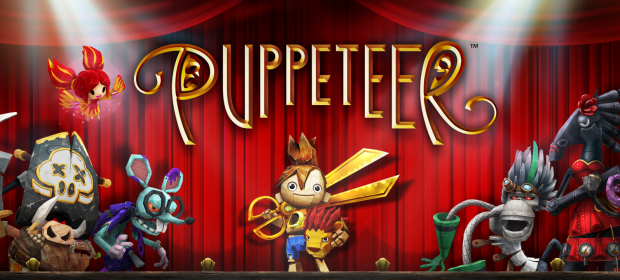While Nintendo are often heralded as the Kings of first-party development, it’s only fair that we doff our caps occasionally in Sony’s direction, too. They might not have the same sense of identity or the sheer number of mega-franchises that Nintendo has, but they’ve had a consistent run recently of good quality first party titles, either for the PlayStation 3 or the Vita. Their Japan Studio in particular has impressed with Gravity Rush and Soul Sacrifice in the last twelve months, and the upcoming Rain looks set to continue the trend when it finally falls from the sky.
SCE Japan have always had a penchant for the slightly strange. Not quite on the same level of odd as, say, Grasshopper Manufacture, they nevertheless like to take risks and experiment with the design of their titles. Their latest platform adventure, Puppeteer, is a shining example of this, standing proudly on the right side of unusual and waving a big pair of scissors at any would-be detractors.
And Puppeteer is an unusual game. While the mechanics themselves surprise more due to their number than their uniqueness, SCE Japan’s platformer packs so much in to such a small space that it really is like watching a rather grand puppet show. It shrugs off the invited preconceptions of immaturity in the first five minutes, as it divulges the backstory of the Moon Bear King, a maleficent deity of a fantasy world that seems to exist within a living puppet show.
Indeed, Puppeteer’s brand of storytelling is as ambiguous as it is compelling. The world of the Moon Bear King is a dark and harrowing place, shot through here and there with black humour and ironic, Disney-baiting faux-whimsy. Characters break the fourth wall to talk to the audience, pass each other lines from off-screen auto-cue cards, and occasionally directly address the player. The tone is irreverent, yet considered, and the narrator’s dry, sardonic timbre compliments the atmosphere wonderfully.
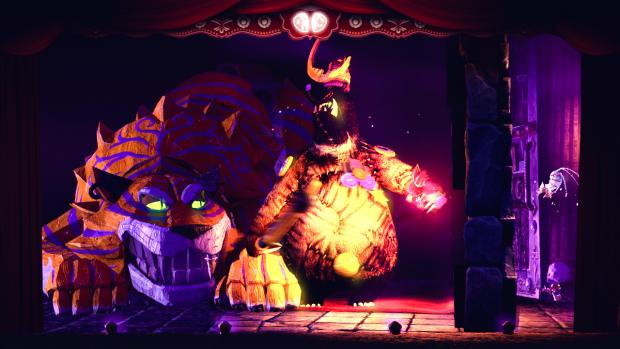
The plot follows Kutaro, a young boy whose soul has been kidnapped by the Moon Bear King and forced into a puppet’s body to serve as a guard in the royal castle. Those who displease the King are cast into slavery, tortured or destroyed. Kutaro has his head torn off, and his body thrown aside – but Kutaro is special. Chosen to be the Champion of the Moon Goddess, he is equipped to vanquish the Moon Bear King and restore the Goddess to the throne.
To do this, Kutaro needs to assemble seven Moonstone Shards, currently under the care of the King’s malicious Generals. Armed with the magical scissors, Calibrus, Kutaro must embark on a quest through seven colourful, musical, and highly dangerous acts to save the kingdom and find a way to return to Earth and his body.
As Kutaro you’re required to navigate the various environments – comprised of 7 Acts of 3 Curtains each, plus 21 bonus stages – defeating the Generals and freeing the souls of your fellow victims along the way. You’ll be aided by a couple of guides, including the mangy witch’s cat, Yin-Yang and the sassy-mouthed Sun Princess Pikarina. As they fly around the environment you can control them with the right stick and click R2 to investigate points of interest.

As you guide our silent protagonist towards his destiny, you’ll be aided and insulted in equal measure by the Moon Witch, a mysterious old crone who intends to use Kutaro to gather the Moonstone Shards so that she can steal them from you herself. She acts as a mentor of sorts, on-hand during the tutorial sections to teach you the basics of each new ability you unlock.
The fact that Kutaro has no head is a surprisingly low barrier to our pioneering puppet, who is able to swap out various objects to serve as a surrogate noggin. These include animals (bats and frogs, for example), crowns, food-stuffs (cauliflowers and burgers), model ships, cogs, fishing rods and bits of old machinery. There are dozens of heads to be found throughout the game – but the insinuation that each head has special properties is slightly misleading.
Each head corresponds to symbols that will flash on the environment when the spotlight lands on them. If you press down on the D-Pad when the symbol is flashing you’ll evoke some kind of event, such as a Wheel of Fortune style spinner, a change to the level or a secret benefit to Kutaro, or you’ll unlock a Bonus Stage.
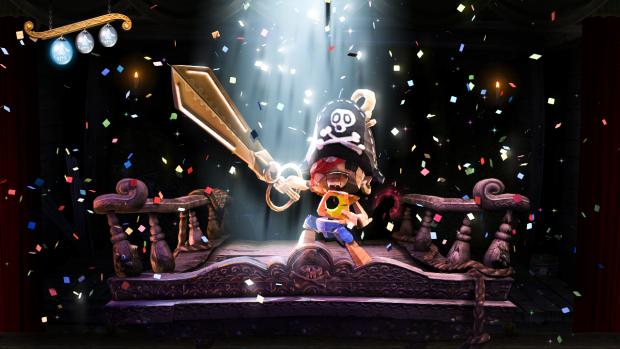
You can equip three heads at a time (though you can’t “choose” them prior to a level), and when you get hit you’ll lose one. Catch it quick enough and there’s no harm done, but lose all three and you’ll lose a life. Lives are recouped by collecting Moonstone slivers that can be found all over each level – for every 100 you find, you’ll earn another try. There are a handful of heads that you’ll always have stashed away, and these correspond to the abilities of the four former Champions of the Moon Goddess, who perished during the Moon Bear King’s rebellion. The first is a Shield to block projectiles (with a press of L1), but you’ll find several others, including a Pirate hook that can manipulate certain objects and a Ninja head that allows you to create bombs.
The pacing is exceptional, as SCE Japan offer a steady stream of upgrades and new abilities as you progress. Every time you feel you’ve seen it all, there’s something else to learn. Indeed, the level design on the whole is some of the best I’ve seen. It’s air-tight, and so well-thought out that it deserves at least the same level of praise as is often given to LittleBigPlanet, another Sony-only platformer – and one with which Puppeteer was initially thought to share similarities. In truth, there’s very little common ground between the two games, despite outward appearances.
The way Puppeteer presents each section of a “Curtain” as a bite-sized challenge, then drops the set and slams new scenery in just like a quick change in a well-produced puppet show, makes it seem more fast-paced than it really is – so much so that you’ll often find yourself dropping into a rhythm as you play and may miss a lot of secrets first time round (thankfully, you can replay any Curtain once it’s completed).
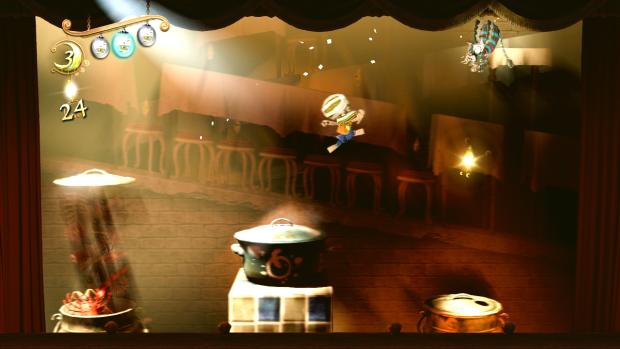
Movement is quite predictably a mix of running and jumping, helped along by the magic of Calibrus. These enchanted scissors can cut through anything made of paper or fabric, which, in a puppet show, is quite a lot. For example, triggering a cannon will cause smoke to billow from the barrel – smoke made of paper, which you can cut through and thus “ride” by continually tapping Square. Now and then you’ll find rope seams that you can rocket along at blistering speed, or you’ll face enemies who must be snipped apart. Standard platform elements abound, from levers and spike-traps to springboards and moving platforms, but the way you navigate them feels unique, almost new again – and that is Puppeteer’s greatest strength. It revels in its own wondrous sense of identity and draws you into the world with its undeniable rhythms and the compelling, bewitching cadence of its gameplay.
The audio and visuals are simply astounding. The world of Puppeteer has more personality than any gameworld I’ve ever seen in a platformer – and that even includes Rayman and LBP. The light and shadow effects are dazzling, the character designs evoking classical Japanese puppetry but with a heavy Western twist. The movement is hypnotic, stringless but still marionette-like, and the colours on display are simply beautiful. Environments range wildly, from dark castles to pirate ships, tropical islands to Wild West-inspired deserts, each one bubbling over with character.
The voice-acting is spot-on, deliberately pantomime but delivered with aplomb, and the musical scoring is perfectly pitched to the on-screen action. It may not quite match Rayman in terms of the music, but it runs a very close second – never more-so than during Act 3’s pirate-themed shenanigans as Kutaro aids Captain Gaff in his battle against two of the Moon Bear King’s Generals, Pig and Sheep. A distinct Pirates of the Caribbean motif runs through the whole Act, and there are moments of genuine excitement as you dodge cannonballs and hack your way up the flaming sails of Gaff’s galleon to battle the duo in one of the epic, QTE-aided boss fights.
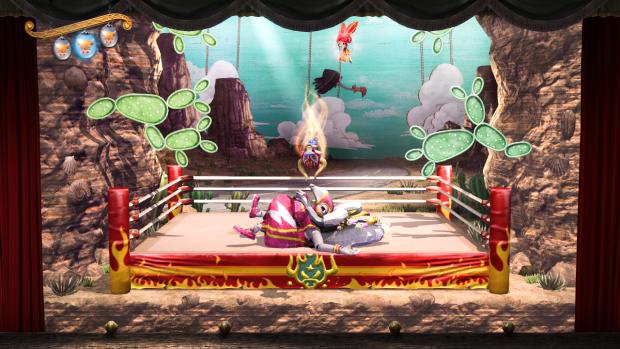
Puppeteer is close to platforming perfection, and the only thing that may not sit well with fans of the genre are the cutscenes. Each one is very long, some running to three or four minutes. It doesn’t sound like much, but it is when you’re itching to get back to solving puzzles and saving the kingdom. Once you stop waiting for them to end (and you can skip them anyway, if you choose) and simply sit and enjoy them, they’re actually brilliant, expositing the story and fleshing out the characters in a colourful, enjoyable way.
VERDICT: There’s very little wrong with Puppeteer, it’s as simple as that. The juxtaposition of cartoonish humour with incredibly dark and macabre imagery and story direction means that even after playing for several hours you’ll still find things to surprise and shock you. The biggest shame of Puppeteer is that it’s likely to amass little more than “cult” status, as there are so many people who simply haven’t heard of it – and it truly deserves to be played.
Puppeteer is one of the year’s best platform games, combining a unique art style with a charmingly disturbed narrative that might even get under your skin if you weren’t so swept away by the grand whimsy of it all. Exceptional.

SUPERB. This is the mark of greatness, only awarded to games that engage us from start to finish. Titles that score 9/10 will have very few problems or negative issues, and will deliver high quality and value for money across all aspects of their design.


